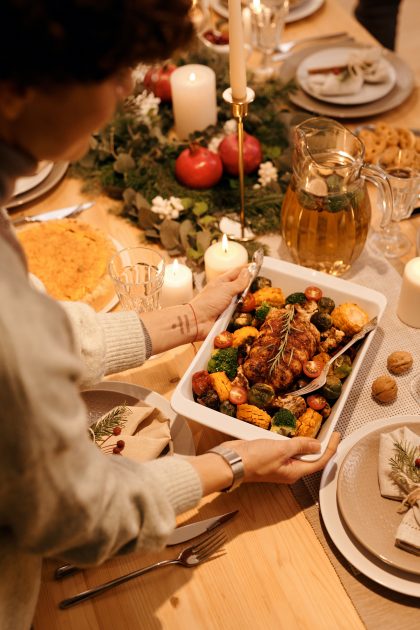
Travelling is undoubtedly one of the major attractions for people to become teachers of English as a Foreign Language. After all, who wouldn’t want to get paid to travel around the world and tick places off your bucket list? But as much as we hate to say it, there are a few downfalls to this nomadic lifestyle, and the biggest one has to be time spent away from family and friends. Of course, we will make new friends but there are definitely times during the year when we just want to be close to those near and dear to us.
And of all the birthday celebrations and festivals and holidays that we might miss, for many of us, Christmas can hurt the most.
Read more: Top 3 Ways to Make Friends While Abroad
On the flip side, while we might miss a few celebrations with our friends and family back home, don’t forget that your new life will also give you new celebrations. From Songkran in Thailand to the Day of the Dead in Mexico, there are endless possibilities to take your mind off what you may be missing at home.
In the same way, even if we can’t be at home for Christmas, there is probably some sort of celebration wherever you are that you can adopt for the festive season. So let’s look at a few of the Christmas traditions around the world that you may find yourself a part of.
Holy Nativity Fast, Egypt
For 43 days before Christmas, Egyptian Christians participate in the Holy Nativity Fast, which is a vegan diet. On Christmas Eve, there is a mass which can last from 10.30 pm until as late as 4 am. After the mass, everyone goes home to celebrate with a Christmas feast which includes all the foods forbidden during the fast.
St Nicholas Day, Germany
On the night of December 5th, children all over Germany dutifully polish their shoes and leave them outside their doors. In the morning, they wake to find their shoes filled with sweets, nuts, and gifts.
Read more: Teach English in Germany
Samichlaus and Schmutzli, Switzerland
On the 6th of December, Samichlaus visits the children of Switzerland and hands out fruits, cookies, and chocolate. But he is not alone. He is accompanied by his helper Schmutzli, who wears a black robe and has a dark beard. He carries an empty bag and his job is to remind the children to be good throughout the year.
The Night of the Little Candles, Colombia
Colombians celebrate 7 December as the start of the festive season. On this night they celebrate Mary and the Feast of the Immaculate Conception by lighting up their houses and streets with millions of little candles in paper lanterns.

La Quema del Diablo, Guatemala
Also on 7 December, at sunset, Guatemalans gather at sunset to burn an effigy of the devil. Bonfires are lit in plazas around the country for the burning, which is believed to cleanse their homes of all the negative happenings of the year.
St. Lucia’s Day, Sweden
On 13 December, Swedes celebrate St. Lucia’s Day. On this day, which marks the beginning of the Christmas festivities, the eldest daughter in the family gets up before dawn. She dresses in a long, white dress, symbolising the patron saint of light who the day is named after. She must go to each family member in the house and serve them coffee and treats with the help of any younger siblings.
13 Yule Lads, Iceland
Iceland celebrates 13 days of Christmas. Each night before Christmas, Icelandic children will put their shoes by their windows. During the night they will be visited by the 13 Yule Lads who will leave either candy or rotten potatoes in their shoes, depending on their behaviour.
Las Posadas, Mexico
Between 16 and 24 December, the festival of Las Posadas is celebrated across Mexico. Children dress in robes and walk in a procession, stopping at houses along the way for refreshments. This is to symbolise Mary and Joseph’s journey from Nazareth to Bethlehem. Adults follow the children and musicians provide music along the route. On the last night, the children celebrate by breaking open pinãtas filled with sweets and toys.
The Giant Lantern Festival, Philipines
On the Saturday before Christmas Eve, the city of San Fernando holds the Giant Lantern Festival. Eleven villages take part in a competition to build the best (read: most elaborate) lantern. While originally the lanterns were made from origami paper and lit by a candle, today the lanterns can measure up to six meters in diameter and are lit by electric bulbs. They truly are a sight to behold.
Misa de Gallo, Costa Rica
Because the majority of the population in Costa Rica is Roman Catholic, Midnight Mass on Christmas Eve is a very important occasion. Called Misa de Gallo, or the Mass of the Rooster, it is followed by a meal of pork and chicken tamales wrapped in plantain leaves.
Christmas Eve, Poland
In Poland, on Christmas Eve, families wait until the first star has appeared in the sky before they eat dinner together. They eat oplatek (a wafer), with each person breaking off a piece as they wish each other Merry Christmas. An extra place is set at the table for any uninvited guests.
Read more: 7 Budget-Friendly Destinations in Europe
Giving apples, China
Only 1% of the Chinese population is Christian, but this doesn’t stop them from celebrating Christmas! As the world’s largest manufacturer of plastic Christmas trees and decorations, the major Chinese cities are decorated every year to mark the occasion. Though Christmas Day itself is largely uneventful (except for the ex-pats there), many Chinese people give each other a gift of apples.
KFC Dinner, Japan
While historically the Japanese don’t really celebrate Christmas – with only a small percentage of the population being Christian – lately a new tradition has become popular, and it’s quite a simple one. Instead of a turkey or mince pies or mulled wine, a Japanese Christmas dinner is now a smorgasbord of all things Kentucky Fried Chicken. It all started in 1974 with a KFC marketing campaign which promoted Kentucky Fried Chicken for Christmas dinner, and the tradition still continues today. In fact, an estimated 3.6 million families in Japan enjoy some of the Colonel’s festive fried chicken for Christmas dinner each year.
Ganna, Ethiopia
In Ethiopia, Christmas is celebrated on 7 January. On this day, people dress in traditional white cotton cloths with brightly coloured stripes at the ends.
As you can see, Christmas is done quite differently in different parts of the world. If you are away from home during the festive season, make sure you find out what your local community does to celebrate this time of year, and be sure to take part in communal celebrations. So even if you can’t be at home, you can still feel at home.
The post Christmas the TEFL Way: Around the World! appeared first on The TEFL Academy Blog.


